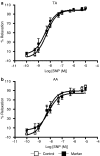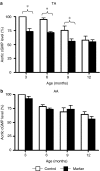Endothelial dysfunction and compromised eNOS/Akt signaling in the thoracic aorta during the progression of Marfan syndrome
- PMID: 17339838
- PMCID: PMC2013910
- DOI: 10.1038/sj.bjp.0707181
Endothelial dysfunction and compromised eNOS/Akt signaling in the thoracic aorta during the progression of Marfan syndrome
Abstract
Background and purpose: Aortic complications account for the major mortality in Marfan syndrome (MFS), a connective tissue disorder caused by mutations in FBN1 encoding fibrillin-1. We hypothesized that MFS impaired endothelial function and nitric oxide (NO) production in the aorta.
Experimental approach: Mice (at 3, 6, 9 and 12 months of age) heterozygous for the Fbn1 allele encoding a cysteine substitution (Fbn1 (C1039G/+), Marfan mice, n=75), the most common class of mutation in MFS, were compared with age-matched control littermates (n=75). Thoracic and abdominal aortas from the two groups were studied.
Key results: Isometric force measurements revealed that relaxation to ACh (but not to sodium nitroprusside) was diminished in the phenylephrine-precontracted Marfan thoracic aorta at 6 months of age (pEC(50)=6.12+/-0.22; maximal response, E(max)=52.7+/-6.8%; control: pEC(50)=7.34+/-0.19; E(max)=84.8+/-2.2%). At one year, both inhibition of NO production with N(omega)-nitro-L-arginine methyl ester, or denudation of endothelium increased the phenylephrine-stimulated contraction in the control thoracic aorta by 35%, but had no effect in the Marfan aorta, indicating a loss of basal NO production in the Marfan vessel. From 6 months, a reduced phosphorylation of endothelial NOS (eNOS)(Ser1177) and Akt(Thr308) detected by Western blotting was observed in the Marfan thoracic aorta, which was accompanied by decreased levels of cGMP. Expressions of Akt and eNOS in the abdominal aorta were not different between the two groups.
Conclusions and implications: MFS impairs endothelial function and signaling of NO production in the thoracic aorta, suggesting the importance of NO in the age-related progression of thoracic aortic manifestations.
Figures





References
-
- Bank AJ, Kaiser DR, Rajala S, Cheng A. In vivo human brachial artery elastic mechanics: effects of smooth muscle relaxation. Circulation. 1999;100:41–47. - PubMed
-
- Boutouyrie P, Bezie Y, Lacolley P, Challande P, Chamiot-Clerc P, Benetos A, et al. In vivo/in vitro comparison of rat abdominal aorta wall viscosity. Influence of endothelial function. Arterioscler Thromb Vasc Biol. 1997;17:1346–1355. - PubMed
-
- Bradley TJ, Potts JE, Potts MT, DeSouza AM, Sandor GG. Echocardiographic Doppler assessment of the biophysical properties of the aorta in pediatric patients with the Marfan syndrome. Am J Cardiol. 2005;96:1317–1321. - PubMed
-
- Castillo C, Reyes G, Escalante B, Lopez P, Castillo EF. Endothelium-dependent vasodilatation in rat aorta is mainly mediated by nitric oxide. Proc West Pharmacol Soc. 1997;40:39–40. - PubMed
-
- Ceravolo R, Maio R, Pujia A, Sciacqua A, Ventura G, Costa MC, et al. Pulse pressure and endothelial dysfunction in never-treated hypertensive patients. J Am Coll Cardiol. 2003;41:1753–1758. - PubMed
Publication types
MeSH terms
Substances
Grants and funding
LinkOut - more resources
Full Text Sources
Other Literature Sources
Medical
Molecular Biology Databases

